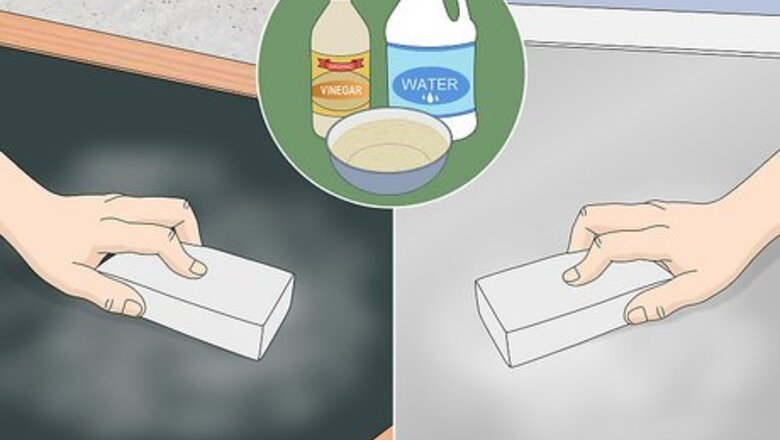
views
- Use a Magic Eraser, water and vinegar, ammonia-based cleaner, glass cleaner, or chalkboard cleaner on porous surfaces like chalkboards, wood, and slate.
- For non-porous surfaces like glass, metal, whiteboards, or sealed chalkboards, use water and mild dish soap to remove chalk marker ink.
- Season your chalkboard to prevent staining by rubbing a stick of chalk lengthwise in both directions against the surface. Wipe with a dry cloth, then a damp cloth.
Magic Eraser
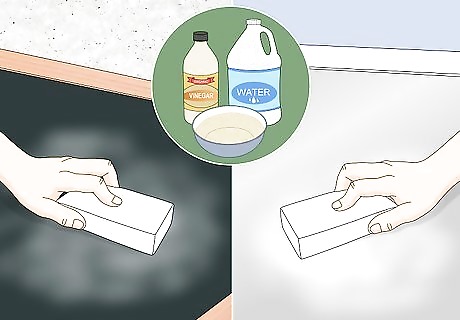
Use a Magic Eraser for porous and non-porous surfaces. Dampen a Magic Eraser with water or a mixture of water and vinegar. Use small, circular movements across the board. Wipe across the entire surface, making sure you hit all the chalk markings. Go over the board with a dry rag. Repeat the process if necessary until all the chalk marker is completely removed from the board's surface. Your chalkboard is porous if the chalk marker can’t be wiped away with a paper towel after 24 hours. Nonporous surfaces include glass, metal, whiteboards, and other surfaces where it’s difficult for water or air to soak in. Porous surfaces include wood and slate. Use the Magic Eraser like a sponge—make sure to squeeze out most of the water or water-vinegar solution and apply pressure as you wipe the board. You can cut a Magic Eraser in half to get more use out of each one. Unless your chalkboard is a large surface, you might not need the whole eraser to do the job.
Water and Vinegar

Use water and vinegar for porous chalkboards and wood surfaces. You can also use this mixture to carefully remove chalk marker from walls and painted surfaces. Start by mixing a ratio of 4 cups (950 mL) of lukewarm water with ⁄2 cup (120 mL) of white vinegar. Wet a cloth or a soft sponge with the water-vinegar mixture or use a Magic Eraser. Wring out the excess liquid before wiping on the surface, moving in gentle circular motions to loosen the chalk marker. Let the liquid sit for 5 to 7 minutes, then gently scrub again at the remaining ink. Allow the surface to air-dry or use a dry soft towel to mop up any leftover liquid. Let the surface completely dry before you start drawing again. If there are still visible markings left after the surface dries, repeat these steps. If you need to clean a larger area, double the amount of water and vinegar, but make sure you stick to the ratio. As an added bonus, the vinegar from the solution also disinfects the surface, so there’s no need to disinfect it before drawing again.
Comet and Water
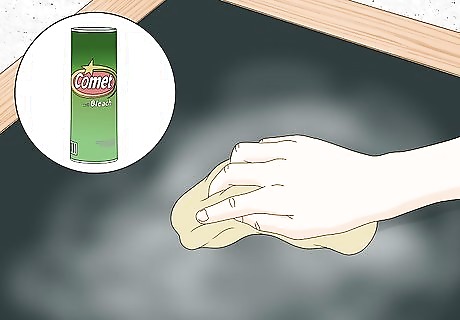
Use Comet and water on porous and non-porous chalkboards. Wet a sponge, rag, or Magic Eraser with water. Then, sprinkle 1-2 tablespoons of an ammonia-based cleaner like Comet on the surface of the chalkboard. Rub with a microfiber cloth or sponge to remove chalk markings. Rub in different directions over the chalk marker, using pressure to go over any tough spots. Wet a paper towel with water to remove the leftover suds. Go over the surface once more with a dry paper towel or cloth to get rid of any streaks. Even though ammonia-based cleaners are safe to use on surfaces, they can be dangerous if they’re inhaled or come in contact with skin or eyes. Make sure you open a window and wear gloves when using ammonia-based cleaners. If there are any spots that still have ghosting (leftover faded chalk), sprinkle a small amount of cleaner and go over it once more with the sponge or rag. If there’s still streaking left over, spray the surface with any glass cleaner and wipe it down with a dry rag.
Glass Cleaner
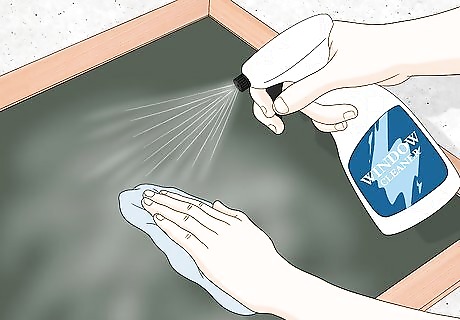
Use a window cleaner on chalkboards and glass surfaces. Spray Windex or any glass cleaner over the area you want to wipe down. Use a clean rag or microfiber cloth to wipe away the chalk marker. If you’re cleaning a chalkboard, grab a piece of traditional stick chalk and draw over any ghost markings. Let the chalkboard sit for 5 to 10 minutes so the surface can absorb the chalk. Spray the window cleaning solution over the chalk. Wipe it again with your cloth to remove all remaining chalk marker residue. If you’re cleaning glass and the chalk marker still doesn’t come off, spray glass cleaner on the surface again. Allow the glass cleaner to sit for 5 minutes, then wipe. Repeat this process until the surface is completely free of markings.
Soap and Water
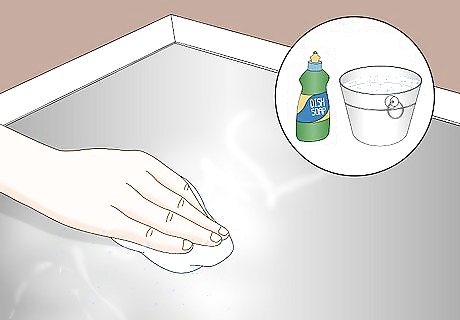
Use soap and water for glass and metal surfaces. This method also works well for painted chalkboard surfaces because it’s less likely to damage the surface. Fill a container or bucket with clean water. Mix a mild dish soap or detergent into the water, and wet a rag, sponge, or microfiber cloth in the mixture. Rub the chalk marker in a circular motion. Use pressure and continue rubbing until the marker comes off. If the marker isn’t coming off quickly, let the soapy water sit on the surface for a few minutes before rubbing again. When all of the marker comes off, use a microfiber cloth to dry the surface. If there is still marker residue left on the area, repeat this process again until you’re happy with the results. If you’re getting chalk marker off car paint, try soap and water first, and always use a microfiber cloth—it’s less likely to scratch the area you’re cleaning. If that doesn’t work, try an automotive glass cleaner or an automotive all-purpose cleaner. For metal surfaces, prepare the soapy water mixture in a spray bottle and spray the surface. If the chalk marker doesn’t come off with soap and water, you may need to use a solvent like WD-40 or rubbing alcohol. Use a sponge or a cloth and dip it into either solvent, let it sit on the surface for 15 to 20 minutes, then rub in a circular motion until the marker comes off. Use soapy water to remove any residual solvent.
Rubbing Alcohol
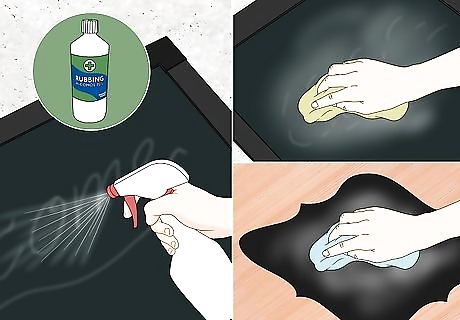
Use rubbing alcohol on LED writing boards and chalkboard labels. For surfaces where soap and water alone would do more damage than good, rubbing alcohol might do the trick instead. Dilute ⁄2 cup (120 mL) of isopropyl alcohol with ⁄2 cup (120 mL) of distilled or pure water and use a spray bottle to spritz the solution all over the surface. Use a clean rag or Magic Eraser to rub the chalk marker in circular motions until all of it is removed. After all the marker is gone, use a dry cloth to wipe the surface clean. If there’s still marker residue, repeat after the surface is dried, until all the chalk marker is removed. If you’re not sure if your chalkboard surface is painted, make sure to test the alcohol on a small corner before spraying it over the surface. Rubbing alcohol may not work on really old chalkboard ink—this method works best for newer stains and for carefully removing marker ink on gentle surfaces like LED boards and sticker labels.
Baby Wipes
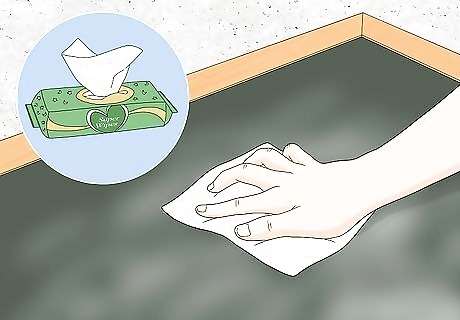
Use baby wipes for chalkboards and glass surfaces. Baby wipes have many incredible uses—one of them being that they can be used to clean and disinfect mirrors and drinking glasses without scratching the surface. Just gently rub the glass with a baby wipe in a circular motion. If any pieces of baby wipe stick to the surface of the glass after you’re finished, wipe them off with a slightly damp cloth or paper towel. You might have to go through several wipes, especially if the chalk marker ink is old. If the wipes begin to tear or break away during the cleaning process, grab a new one to finish the job.
Chalkboard Cleaner
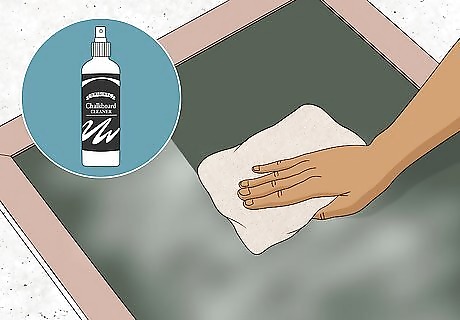
Use a chalkboard cleaner. Try a chalkboard cleaning kit that comes with a special spray, a microfiber cloth, and a couple of Magic Erasers. Pump the spray bottle a couple of times. Lightly coat the surface of your chalkboard and let the cleaning solution sit for 10-15 minutes. Wipe away the solution with a microfiber cloth, sponge, or Magic Eraser. Allow the surface to completely dry before marking up the chalkboard again. If you have kids, make sure that the cleaning solution is non-toxic and water-based so it’s safe for them to use too! You may have to go over the surface again with the cleaner to completely get rid of all the ghost markings. If the chalkboard cleaner doesn’t seem to work by itself, try adding a little bit of vinegar and water to the board and wiping it down again.
Seasoning the Chalkboard
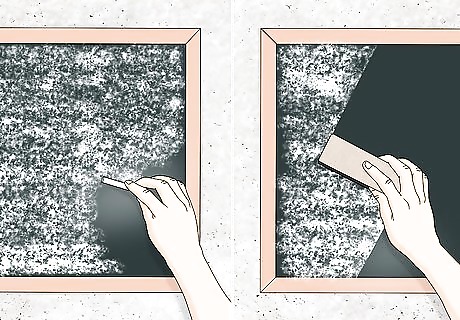
Season your chalkboard to prevent it from ghost markings in the future. Seasoning your chalkboard is like priming a wall before you paint—it helps the chalk or chalk marker draw on smoothly and come off more easily. All you need is a stick of traditional white chalk. Lightly rub the chalk on its side over the surface of your board. Swipe in an up-and-down motion, covering the entire chalkboard. Then, repeat the same motion, this time going side-to-side. Erase your board with a blackboard eraser or a soft cloth. If you want your board to look “newer” and darker, get a cloth slightly damp with glass cleaner or water and gently wipe down the surface again. If your chalkboard is porous, use traditional chalk instead of chalk marker to draw or write in order to minimize damage to your chalkboard. The goal is to fill in all of the pores of your chalkboard with chalk dust, which can help prevent scratches and keep chalk marker ink from soaking into your board. Repeat this process every time you wash the chalk marker off your board to prevent the marker from soaking in and creating ghost markings in the future.












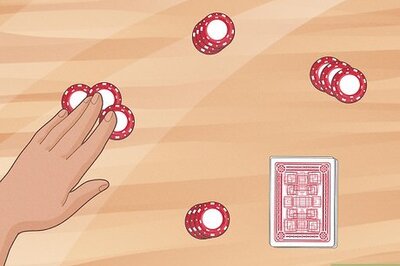





Comments
0 comment